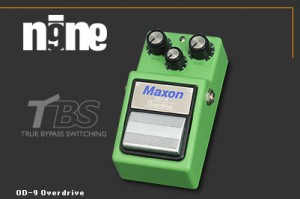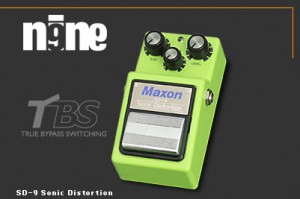OD-9: Suggested retail price – $140
 The Maxon OD-9 leads off the 9-Series of pedals and in fact looks just like the original Ibanez TS-9 tube screamer. There’s good reason for that since Maxon is actually the manufacturer for the classic effect – look inside a TS-9 on the circuit board and you’ll see the Maxon name! So let’s dig in a bit more and see what’s new with Maxon’s own OD-9 Overdrive.
The Maxon OD-9 leads off the 9-Series of pedals and in fact looks just like the original Ibanez TS-9 tube screamer. There’s good reason for that since Maxon is actually the manufacturer for the classic effect – look inside a TS-9 on the circuit board and you’ll see the Maxon name! So let’s dig in a bit more and see what’s new with Maxon’s own OD-9 Overdrive.
Features
Responding to the demands of customers, Maxon now employs a true-bypass switching circuit within all its 9-Series pedals and this is a welcome addition to the OD-9 as well for lovers of the Tube Screamer sound but who want a completely pure-signal when the pedal is bypassed. The OD-9 also uses an actual JRC4558D chip, rather than the Toshiba chip used in the Ibanez TS-9 Tube Screamer reissue – again, a welcome benefit. The OD-9 also includes a bit of revised circuitry, with the inclusion of the same value output resistors that were used in the original and now legendary TS-808 Tube Screamer.
Like the Ibanez TS-9, the pedal features knobs for drive, level, and tone. It also has a no tools battery compartment, and a 9-volt AC jack. The manual includes sample settings, with separate specs for humbuckers versus single coil pickups and clean amp versus dirty amp. This is a plus, since it’s always nice to have some manufacturer suggested guidelines to start with.
Construction
Like the TS-9 reissue also made by Maxon, the build quality of the OD-9 is first-rate especially when looking within the world of a mass produced effects where the trend has been to reduce costs whenever possible. Unlike lower-cost units out there, there are no short-cuts taken with the manufacturing that will be a cause for problems to crop up in the future. For example, the jacks and potentiometers are quality units that are wired separately to the board, rather than being types that are directly soldered to the printed circuit board. Direct-mount components can cause cracking of solder traces over time leading to a malfunctioning unit for example, especially if the jacks or pots become loose.
The casing is a heavy duty zinc aluminum material that ensures that the OD-9 will be durable and hold up to heavy road-use when compared to effects housed in plastic enclosures. Thumbs up overall for Maxon continuing its approach in ensuring that quality remains a key component in their pedals!
Sound Quality
The most highly-regarded Tube Screamer, the TS-808 has a sound that is known for having an overdrive that is warm and natural, smooth in gain, and for having a bit of midrange that helps bring leads more “up front” in the mix. The second-generation TS-9 Tube Screamer was cited in contrast to having a bit more of a biting and trebly character and a bit more of an aggressive type of overdrive. This difference has lead to quite a number of TS-9 Tube Screamers being modified to the original TS-808 circuit as the general consensus is that the original TS-808s were more “tube-like” in their tone.
Maxon states that the OD-9 Maxon was designed with the original Tube Screamer circuitry in mind and has made all the necessary changes in resistors and with the inclusion of the JRC4558D chip. Indeed, the OD-9 exhibits the warm character of the original Tube Screamer, but at a price more in line with the player, rather than the collector of vintage pedals (check Ebay for the prices of original TS-808 Tube Screamers – you may be in for a shock!)
Strat players in particular will really enjoy the OD-9 the most as the bit of midrange color that the OD-9 adds is quite complementary. The OD-9 also worked well when used as a boost to push the amp tubes into further distortion and in fact this is my favorite application for this pedal. Nothing sounds better than a great tube amp being overdriven and the OD-9 is again quite a complement when seeking to get a bit more out of your tube amplifier in the gain department.
Summary
Overall, the OD-9 is my personal favorite Tube Screamer produced to date as it incorporates the best of the classic circuitry along with the modern refinements that guitarists today demand. For those that want the quality original Tube Screamer tone without the need to perform modifications, the OD-9 is clearly the best choice out there.
SD-9: Suggested Retail Price – $150
Maxon refers to the SD-9 as one of their “most esoteric models” and as having “gained a huge cult following since its initial release in the early 1980s”. The selling point of the SD-9 is its alleged ability to provide a wide range of distortion tones, “from punchy overdrive to blistering fuzz, all with full-frequency response and minimal tonal coloration.”
Features
Maxon says that the secret to the SD-9’s versatility is its deceptively simple component configuration – that with fewer components to hold down your tone, “more sonic information is passed to the output yielding a more authentic reproduction of your guitar sound.” The SD-9 provides 42 dB of gain and also has low range boost/cut circuit for added bottom end. The pedal also “features the JRC4558 IC chip, generally regarded as sonically superior to other op amp models.” The combination of these two elements supposedly creates a pedal with more low-end punch than other distortions. The pedal features three knobs for dialing in drive, level, and tone.
Construction
Looks and feels solid. It has the same construction and appearance as the OD-9, save that the color is a little more yellow-ish.
Sound Quality
Some distortion pedals have a general sound that doesn’t change all that much regardless of where you dial it in. This is NOT one of those pedals. If you have it set wrong, you could easily get a very tinny, overly bright and thin sound that would lead you to decide that the SD-9 is a real piece of crap. With some distortion pedals, I like to crank the drive and the tone for maximum sustain and gain. But with the SD-9, you must roll back the tone knob, or else your sound is going to be too bright and brittle. You might also adjust your guitar’s tone knob(s), and it will be necessary to play around with both to find your best sound. But once you do, the SD-9 does deliver some of what it promises. I’m not necessarily sold on the SD-9’s versatility. It’s not going to stand in very well for a light TS-9 style overdrive, and you can probably find something better for Metallica-type metal riffing. But the SD-9 does at least one thing very well, and that is the “blistering fuzz”. I am a big fan of the full-frequency wall of fuzz that Billy Corgan pioneered on the first couple of Smashing Pumpkins albums. And the SD-9 can dial in a pretty nice Pumpkins-style fuzz on power chords and things like the main riff from “Cherub Rock” and accompanying harmonics. I like it with the drive at 3 o’clock and tone at 1 o’clock. Likewise, it sounds pretty good on Nirvana-style chord progressions. This setting also gets a very fat and smoothe sustain for leads.
Conclusion
As with most pedals, it really depends on what kind of sound you are looking for. I can’t recommend the SD-9 for classic rock or straight metal. But those who are into the early 90s grunge/alternative/“Seattle Sound” should dig this pedal… as long as they remember that it is hugely important to be conscious of the high-frequency tonal parameters.